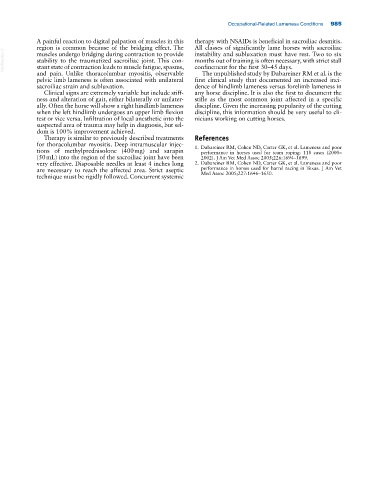Page 1019 - Adams and Stashak's Lameness in Horses, 7th Edition
P. 1019
Occupational‐Related Lameness Conditions 985
A painful reaction to digital palpation of muscles in this therapy with NSAIDs is beneficial in sacroiliac desmitis.
region is common because of the bridging effect. The All classes of significantly lame horses with sacroiliac
VetBooks.ir stability to the traumatized sacroiliac joint. This con months out of training is often necessary, with strict stall
instability and subluxation must have rest. Two to six
muscles undergo bridging during contraction to provide
confinement for the first 30–45 days.
stant state of contraction leads to muscle fatigue, spasms,
and pain. Unlike thoracolumbar myositis, observable The unpublished study by Dabareiner RM et al. is the
pelvic limb lameness is often associated with unilateral first clinical study that documented an increased inci
sacroiliac strain and subluxation. dence of hindlimb lameness versus forelimb lameness in
Clinical signs are extremely variable but include stiff any horse discipline. It is also the first to document the
ness and alteration of gait, either bilaterally or unilater stifle as the most common joint affected in a specific
ally. Often the horse will show a right hindlimb lameness discipline. Given the increasing popularity of the cutting
when the left hindlimb undergoes an upper limb flexion discipline, this information should be very useful to cli
test or vice versa. Infiltration of local anesthetic into the nicians working on cutting horses.
suspected area of trauma may help in diagnosis, but sel
dom is 100% improvement achieved.
Therapy is similar to previously described treatments References
for thoracolumbar myositis. Deep intramuscular injec
tions of methylprednisolone (400 mg) and sarapin 1. Dabareiner RM, Cohen ND, Carter GK, et al. Lameness and poor
performance in horses used for team roping: 118 cases (2000–
(50 mL) into the region of the sacroiliac joint have been 2002). J Am Vet Med Assoc 2005;226:1694–1699.
very effective. Disposable needles at least 4 inches long 2. Dabareiner RM, Cohen ND, Carter GK, et al. Lameness and poor
are necessary to reach the affected area. Strict aseptic performance in horses used for barrel racing in Texas. J Am Vet
technique must be rigidly followed. Concurrent systemic Med Assoc 2005;227:1646–1650.

